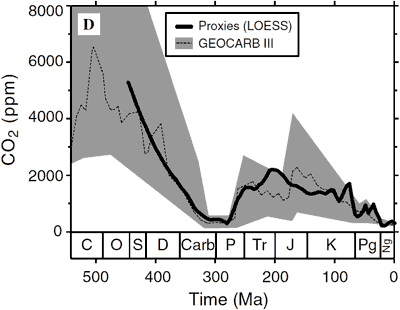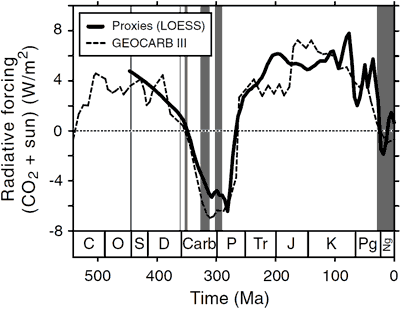 Arguments
Arguments
 Software
Software
 Resources
Comments
Resources
Comments
 The Consensus Project
The Consensus Project
 Translations
Translations
 About
Support
About
Support


Latest Posts
- Fact brief - Does clearing trees for solar panels release more CO2 than the solar panels would prevent?
- Where things stand on climate change in 2026
- 2026 SkS Weekly Climate Change & Global Warming News Roundup #02
- Skeptical Science New Research for Week #2 2026
- UK renewables enjoy record year in 2025 – but gas power still rises
- Six climate stories that inspired us in 2025
- How to steer EVs towards the road of ‘mass adoption’
- 2026 SkS Weekly Climate Change & Global Warming News Roundup #01
- Skeptical Science New Research for Week #1 2026
- 2025 in review - busy in the boiler room
- Direct Air Capture
- IEA: Declining coal demand in China set to outweigh Trump’s pro-coal policies
- 2025 SkS Weekly Climate Change & Global Warming News Roundup #52
- Skeptical Science New Research for Week #52 2025
- How climate change broke the Pacific Northwest’s plumbing
- Fact brief - Do solar panels generate more waste than fossil fuels?
- Zeke's 2026 and 2027 global temperature forecasts
- 2025 SkS Weekly Climate Change & Global Warming News Roundup #51
- Skeptical Science New Research for Week #51 2025
- What are the causes of recent record-high global temperatures?
- Fact brief - Are toxic heavy metals from solar panels posing a threat to human health?
- Emergence vs Detection & Attribution
- 2025 SkS Weekly Climate Change & Global Warming News Roundup #50
- Skeptical Science New Research for Week #50 2025
- The rest of the world is lapping the U.S. in the EV race
- Fact brief - Are electromagnetic fields from solar farms harmful to human health?
- Comparing climate models with observations
- 2025 SkS Weekly Climate Change & Global Warming News Roundup #49
- Skeptical Science New Research for Week #49 2025
- Climate Adam & Dr Gilbz - Paris Climate Agreement At 10: Did It Do Anything?
Archived Rebuttal
This is the archived Intermediate rebuttal to the climate myth "CO2 was higher in the past". Click here to view the latest rebuttal.
What the science says...
|
When CO2 levels were higher in the past, solar levels were also lower. The combined effect of sun and CO2 matches well with climate. |
Please note: Records of past CO2 and temperature have improved considerably since this rebuttal was written, reconfirming CO2 is the principal ‘control knob’ on climate. This rebuttal is currently being revised and an updated version will be published as soon as it becomes available.
Over the Earth's history, there are times where atmospheric CO2 is higher than current levels. Intriguingly, the planet experienced widespread regions of glaciation during some of those periods. Does this contradict the warming effect of CO2? No, for one simple reason. CO2 is not the only driver of climate. To understand past climate, we need to include other forcings that drive climate. To do this, one study pieced together 490 proxy records to reconstruct CO2 levels over the last 540 million years (Royer 2006). This period is known as the Phanerozoic eon.

Figure 1: Atmospheric CO2 through the Phanerozoic. Dashed line shows predictions of the GEOCARB carbon cycle model with grey shading representing uncertainty range. Solid line shows smoothed representation of the proxy record (Royer 2006).
Atmospheric CO2 levels have reached spectacular values in the deep past, possibly topping over 5000 ppm in the late Ordovician around 440 million years ago. However, solar activity also falls as you go further back. In the early Phanerozoic, solar output was about 4% less than current levels. The combined net effect from CO2 and solar variations are shown in Figure 2. Periods of geographically widespread ice are indicated by shaded areas.

Figure 2: Combined radiative forcing from CO2 and sun through the Phanerozoic. Values are expressed relative to pre-industrial conditions (CO2 = 280 ppm; solar luminosity = 342 W/m2). The dark shaded bands correspond to periods with strong evidence for geographically widespread ice.
Periods of low CO2 coincide with periods of geographically widespread ice (with one notable exception, discussed below). This leads to the concept of the CO2-ice threshold - the CO2 level required to initiate a glaciation. When the sun is less active, the CO2-ice threshold is much higher. For example, while the CO2-ice threshold for present-day Earth is estimated to be 500 ppm, the equivalent threshold during the Late Ordovician (450 million years ago) is 3000 ppm.
However, until recently, CO2 levels during the late Ordovician were thought to be much greater than 3000 ppm which was problematic as the Earth experienced glacial conditions at this time. The CO2 data covering the late Ordovician is sparse with one data point in the CO2 proxy record close to this period - it has a value of 5600 ppm. Given that solar output was around 4% lower than current levels, CO2 would need to fall to 3000 ppm to permit glacial conditions. Could CO2 levels have fallen this far? Given the low temporal resolution of the CO2 record, the data was not conclusive.
Research examining strontium isotopes in the sediment record shed more light on this question (Young 2009). Rock weathering removes CO2 from the atmosphere. The process also produces a particular isotope of strontium, washed down to the oceans via rivers. The ratio of strontium isotopes in sediment layers can be used to construct a proxy record of continental weathering activity. The strontium record shows that around the middle Ordovician, weatherability increased leading to an increased consumption of CO2. However, this was balanced by increased volcanic outgassing adding CO2 to the atmosphere. Around 446 million years ago, volcanic activity dropped while rock weathering remained high. This caused CO2 levels to fall below 3000 ppm, initiating cooling. It turns out falling CO2 levels was the cause of late Ordovician glaciation.
So we see that comparisons of present day climate to periods 500 million years ago need to take into account that the sun was less active than now. What about times closer to home? The last time CO2 was similar to current levels was around 3 million years ago, during the Pliocene. Back then, CO2 levels remained at around 365 to 410 ppm for thousands of years. Arctic temperatures were 11 to 16°C warmer (Csank 2011). Global temperatures over this period is estimated to be 3 to 4°C warmer than pre-industrial temperatures. Sea levels were around 25 metres higher than current sea level (Dwyer 2008).
If climate scientists were claiming CO2 was the only driver of climate, then high CO2 during glacial periods would be problematic. But any climate scientist will tell you CO2 is not the only driver of climate. Climatologist Dana Royer says it best: "the geologic record contains a treasure trove of 'alternative Earths' that allow scientists to study how the various components of the Earth system respond to a range of climatic forcings." Past periods of higher CO2 do not contradict the notion that CO2 warms global temperatures. On the contrary, they confirm the close coupling between CO2 and climate.
Intermediate rebuttal written by John Cook
Update July 2015:
Here is a related lecture-video from Denial101x - Making Sense of Climate Science Denial
Updated on 2015-07-06 by pattimer.
THE ESCALATOR

(free to republish)
























































